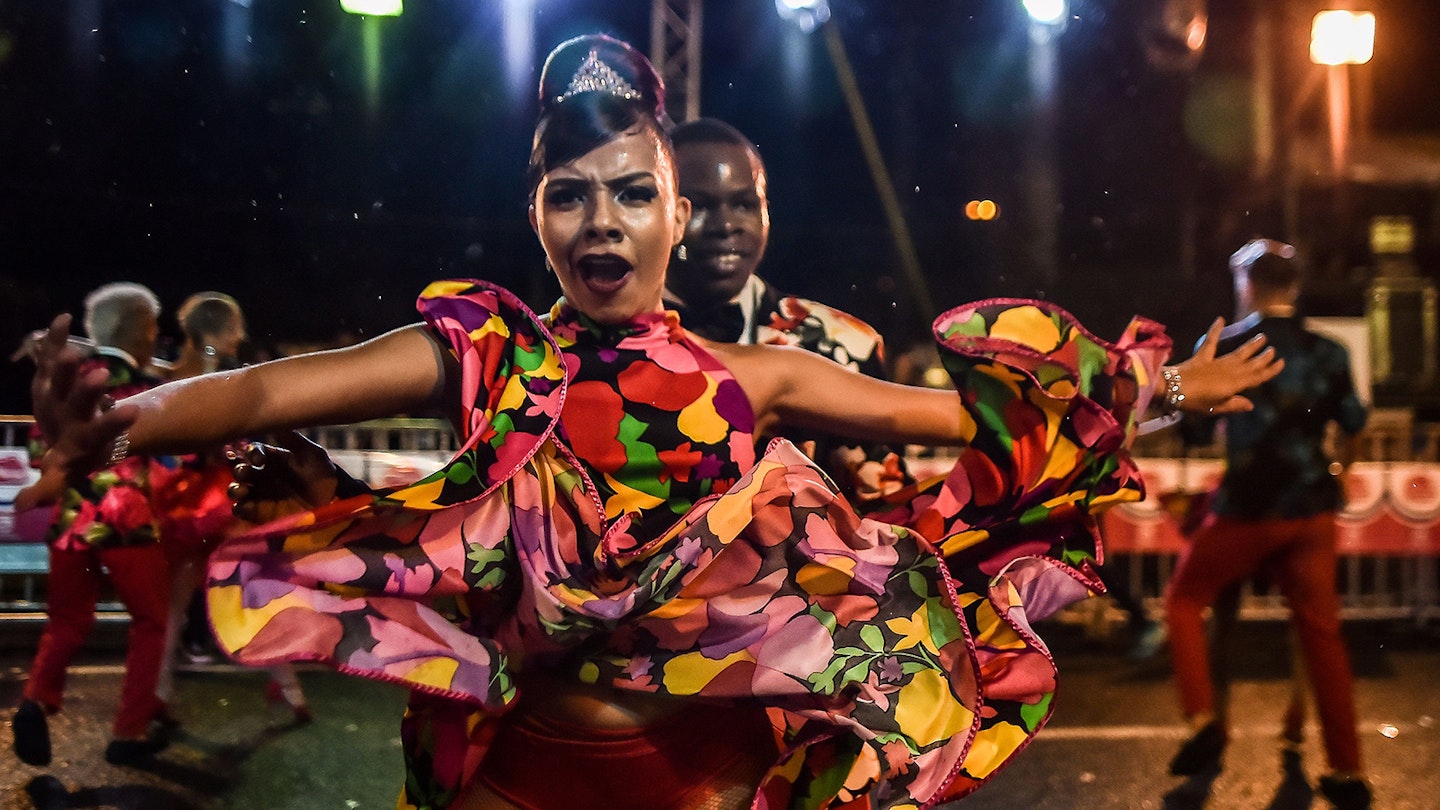Cali may not be as scenic as Medellín or cosmopolitan as Bogotá, but the vibrant attitude of the local caleños is enough to win you over. Moreover, as a society built upon the blending of indigenous, African, and Spanish traditions, diversity and open-mindedness form the base of the caleño culture.
From celebrating Afro-Colombian heritage and viewing modern art to salsa dancing and exploring historic architecture, here are our favorite ways to discover Cali’s culture and history.
Dive into Salsa Mania
We cannot talk about Cali without mentioning salsa. Considered the salsa capital of the world, caleños live and breathe to the music’s energetic pulse. Be prepared to hear it everywhere you go, from buses and taxis to salsa bars, restaurants, and tiendas (tiny neighborhood stores).
The best place to experience Cali’s obsession with salsa is on the dance floor. Although a dedicated practice is needed to master this dance style, learning some basic steps will certainly give you confidence. El Manicero dance academy is visitor-friendly, and its group classes are good value for money. The legendary salsa club Tin Tin Deo offers free lessons on Thursday nights, and don’t worry if you lack a partner – the local regulars are happy to oblige. Alternatively, get inspired by the city’s renowned salsa show, Delirio: an extravagant, Cirque du Soleil-like spectacle that takes place every last Friday of the month. Expect to be blown away by jaw-dropping choreographies and circus acts. Booking (well in advance) is essential.
Explore the City’s History
Cali’s city center boasts several historical monuments and churches worth visiting. People-watch in the palm-filled Plaza de Caicedo framed by the Republican-style Edificio Otero and the neoclassical San Pedro Cathedral and Palacio Nacional. Appreciate the beautiful paintings that adorn the ceilings of the Iglesia de San Francisco or the gilded altar at the 472-year-old La Merced, the city’s oldest church. Within the church’s former convent, you can view colonial religious art and pre-Colombian pottery and artifacts at the Museo de Arte Religoso La Merced and the Museo Arqueológico La Merced, respectively. Just one block away, you can view a small collection of gold and pottery of the Calima culture at the Museo del Oro.
Take a stroll through the Plaza de los Poetas, a traditional park dotted with statues of poets native to the department of Valle del Cauca. If you’d like a typed letter (to your beloved, maybe), don’t hesitate to ask one of the city’s scribes who sit in the middle of the square under the shade of an umbrella. Their well-used typewriters do the job quite nicely.
Standing to one side of the park is the 20th-century Gothic-style Iglesia de la Ermita. The church’s Dutch musical clocks and windows, French bells, and Italian marble contrast strikingly with the surrounding contemporary architecture. Now’s a good time to slurp up a cholao, a sweet mix of fruit, condensed milk, and flavored syrup, or a lulada, an icy drink made from lime juice and the citrus fruit lulo.
Now that you’re feeling refreshed, amble along the shady boulevard that runs parallel to Rio Cali until you reach El Gato del Rio – a 3.5-ton bronze statue of a cat created by Colombian artist Hernando Tejada. The statue has since inspired other Colombian artists to follow suit and the walkway is now lined with sculptures of smaller cats.
Discover Cali’s Best Neighborhoods
To the east of the city center lies the 16th-century hillside neighborhood, San Antonio – ‘Old Cali’ as it’s locally named. Popular with travelers, the barrio was once home to writers, artists, and musicians and is considered Cali’s bohemian quarter: street musicians entertain passersby and old colonial buildings house hipster cafes, restaurants, and antique stores. The steps of the 18th-century Iglesia de San Antonio offer great views of the sprawling city below.
Foodies will go nuts in the nearby neighborhood of Granada, the city’s gastro zone. Do try the traditional Chuleta Valluna – a marinated, breaded, and fried pork cutlet at Ringlete, a restaurant that is re-inventing traditional cuisine from Valle de Cauca. Alternatively, the cazuela de mariscos, a steaming bowl of seafood cooked in coconut milk, will not disappoint.
Celebrate Diversity
To truly appreciate the city’s passion for celebrating their multifaceted heritage, make sure to be in town from 25-30 December when Cali celebrates the Feria de Cali. The yearly festival sweeps through the streets bringing colorful cultural parades, live local and international music shows, circus performances, tango championships, and salsa parties that continue until dawn.
For a taste of Africa in Colombia, don’t miss the annual Petronio Alvarez Festival, which takes place in August and celebrates the musical heritage of the country’s African descendants. The five-day event attracts local and international artists who come together to celebrate a love for a culture from across the Atlantic Ocean that’s been woven into lyrics, drum beats, and movements.
Enjoy Art and Cine
There’s well-established appreciation for contemporary art and indie films in Cali. Start at the Museo de Arte Moderno La Tertulia, considered the city’s main cultural and artistic hub. Located in a beautiful contemporary building, complete with Greek-inspired columns, the museum consists of a large exhibition hall where over 1300 works of art (paintings, drawings, engravings, and sculptures) by both Colombian and international artists are on display. The complex also houses a library specializing in art, film, photography, and architecture. Film buffs will appreciate La Cinemateca movie theater that screens independent local and international films.
A ten-minute walk from La Tertulia is the country’s first film museum, Caliwood Museo de La Cinematografia where visitors can view hundreds of cameras and projectors, along with an impressive collection of movie posters.
Finally, head to an art center called Lugar a Dudas located in the Granada barrio. Translated as ‘Place to Doubt’, the center focuses on the promotion and dissemination of contemporary artistic practice and serves as an artist residency and exhibition space, research laboratory, and documentation center dedicated to visual arts.





